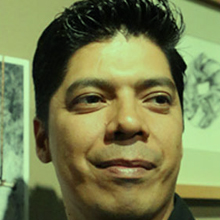Intento ser cada día un artista que utiliza la herramienta del humor para compartirse así mismo.
Es caricaturista, ilustrador, grabadista y pintor, nacido en la Ciudad de Oaxaca, México en 1974. Actualmente es presidente de Cartonclub S.A. de C.V. “El Club de la caricatura Latina”, ha colaborado en el periódico El Imparcial de Oaxaca, la revista Foreign Affairs Latinoamérica y la revista El Chamuco. Su trabajo ha sido publicado en diarios como Le Monde, La Temps, The Nation y The New York Times así como en diversas agencias de medios por internet. Ha expuesto su obra en innumerables países, tanto en exposiciones individuales como colectivas. Ha publicado libros.
Y estos son sus premios (no sé si todos):
Premio Estatal de Periodismo e Información Benito Juárez García en Oaxaca en sus ediciones de 1997, 1999 y 2005, el Premio Nacional de Periodismo José Pagés Llergo en el 2005. En el año 2012 y 2014 y 2015 obtiene el Premio Nacional de Periodismo otorgado por el Consejo Ciudadano en México, así como el premio Nacional “Rostros de la Discriminación Gilberto Rincón Gallardo”. Recibe el Premio Nacional de Periodismo otorgado por el Club de Periodistas de México en 2013. En el año 2011 recibe el Grand Prix y el Primer Premio en la categoría de humor en la edición 38ª del Salón Internacional del humor en Piracicaba, Brasil, así como el Primer Premio en el 5º Salón del Humor en Patio, Brazil (ECOCARTOON) en 2012 y el primer lugar en el tercer Concurso Internacional del Humor “Sinaloa 2014” en México. Ha recibido también Menciones Honoríficas en el Primer concurso de Caricatura Greekartoon 2006 (Ministerio Helénico de Cultura, Atenas, Grecia), en el World Press Cartoon 2007 Sintra (Portugal) y en el 4º Salón Internacional Patio Brasil. En junio de 2019 recibe el Award of Excellence en el 19th International Editorial Cartoon Competition en Canadá otorgado por The Canadian Committee for World Press Freedom y en Agosto del mismo año el Premio a la Excelencia en Periodismo otorgado por la Sociedad Interamericana de Prensa (SIP). En diciembre del año en curso recibe Mención Honorífica en el Premio Nacional de Periodismo 2018 otorgado por el Consejo Ciudadano del PNP…
Me cansé. No es que le deseara que obtuviera menos premios, es que si desean saber más búsquenlo en Google, porque para una presentación lo considero excesivo.
¿Pero quién es este multipremiado señor? Pues el amigo Darío Castillejos.
Tengo el honor y el disfrute de estar con él en este “diáloco”.
Aunque por su curriculum le basta y sobra para entrevistarlo, lo hago mucho porque estuvo como panelista en el lanzamiento del libro de Ángel Boligán y mío –“Historia de bufones”-, y habló muy bien, así que se lo debo. Ah, y además, lo vi recibiendo uno de esos importante premios y lo que dijo -que se relaciona conmigo-, me encantó.
En fin, “dialoquemos” con él después de tan larga presentación…
PP: Querido Darío, ante todo te confieso que ya me está haciendo falta que nos veamos “en vivo” a conversar un café o un vinito, ¿no es cierto? Bienvenido a Humor Sapiens…
DARÍO: Muchas gracias querido Pepe, en verdad que ya nos hace falta una buena charla de esas que se aderezan con una buena comida y desde luego un buen vino o mezcal de Oaxaca, si así lo prefieres.
PP: Café, vino, mezcal, ron o agua, da el igual el pretexto para reunirnos, ja, ja. Bueno, comencemos… ¿Cómo llegaste a esta profesión?
DARÍO: He sentido el llamado al oficio desde muy pequeño, quizá y lo digo sin exagerar, desde antes de pronunciar mis primeras palabras. Ya en el preescolar era mi obsesión jugar con todo aquello con lo que se pudiera hacer un trazo, desde las crayolas hasta los pedazos de tiza o ladrillos que encontraba en cualquier lado. En la primaria descubrí que era la mejor herramienta para socializar y hacer amigos; cosa que no fue muy diferente en la etapa profesional en donde tuve la primera oportunidad de publicar mis dibujos en una pequeña gaceta que llevaba por nombre “La expresión de Oaxaca”, propiedad de un amigo abogado que además era profesor en la facultad de Derecho y Ciencias Sociales, en donde pasé días memorables jugando a estudiar para ser abogado.
PP: ¿No sabías que estudiaste para leguleyo! Muy bien. Pero quiero llevarte hacia las características de tu obra. Por ejemplo, prefieres evidentemente la viñeta sin textos. ¿Por qué?
DARÍO: Siempre he sido una apasionado de la pintura y las artes plásticas y en ellas siempre la imagen es protagonista. Se elabora un diálogo más profundo con el espectador gracias a esa interpretación subjetiva. En la caricatura, el tema es inmediato y el mensaje tiene que ser claro y breve. Mi intención al trabajar conceptualmente la caricatura es precisamente entablar un diálogo con el espectador en donde se permita no sólo el rictus de una sonrisa a flor de piel, sino que el mensaje provoque alguna reflexión y agite de alguna manera la conciencia crítica.
PP: Si yo fuera dibujante haría lo mismo. Me encanta la conceptualización visual en esta modalidad, más que el uso de la palabra. Claro que hay caricaturas buenísimas con texto, pero encontrar el mensaje en un medio visual solo en imágenes, me llena más. Insisto, no es que sea mejor o peor. Es cuestión de gustos, según mi criterio. Pero en fin, has desarrollado tremenda carrera, como se nota en los datos que busqué para presentarte. Y al volver a leerlos ahora, me surge la pregunta: ¿cuál de esos premios que has recibido te ha emocionado más? ¿Cuál es el más significativo?
DARÍO: Cada premio tiene una historia especial pues en cada uno hay emociones y expectativas. Los premios Nacionales de Periodismo en México tienen una significado especial, pues en ellos se reconoce la labor periodística en un país que se considera el lugar más riesgoso para ejercer el oficio. Hay otros que por su relevancia en la profesión sin duda son importantes como es el caso del World Press Cartoon, y el Salón de Humor de Piracicaba, Brasil.
PP: Felicidades por todos ellos. Son merecidos, sin dudas. Amigo mío, también por todo lo anterior te considero un humorista gráfico intenso. Tus caricaturas provocan emociones, impresionan, hacen pensar. Y están cargadas hacia la sátira. De ahí mi pregunta: ¿te consideras un humorista político?
DARÍO: Esa es una pregunta muy interesante porque me traslada a los terrenos de la autocrítica como artista. Me considero un observador de la política pero un escéptico de los políticos. Encuentro en la crítica la mejor manera de expresar mis emociones y es, a través de esta, que doy a conocer también mi opinión no solamente del quehacer político, sino de la vida misma. Intento ser cada día un artista que utiliza la herramienta del humor para compartirse así mismo.
PP: Me gustó eso de “observador de la política y escéptico de los políticos”. Lamentablemente, son tiempos en que los políticos dejan mucho que desear. No sé si se forman con menos rigor, si son menos educados o cultos, con menos ética o son más fanáticos, o todas las anteriores, pero es evidente que le dan muchísimas razones a los humoristas para sus críticas y sátiras en este caso. Bueno, siguiendo esa línea de personalizar a los políticos “criticables”, he visto que varias veces usas personajes reales y los caricaturizas, ¿has pensado en dedicarle más tiempo, neuronas, esfuerzo y energía a la caricatura personal?
DARÍO: Me gustan y disfruto cada rama del dibujo humorístico, el reto que cada una de ellas impone me emociona y motiva. La caricatura personal es una rama del humor gráfico que he abordado muchas veces, pero cada que elaboro un retrato caricaturizado descubro que al final siempre pude haber hecho más. Admiro a muchos colegas que han perfeccionado su técnica de una manera sorprendente y trato de aprender de cada uno de ellos en este camino inagotable de experimentación.
PP: Aunque sufras por la eterna necesidad de perfección del creador, después de finalizar la obra, te aseguro que lo haces bien. Deberías seguir haciéndolo para mi gusto. ¿Te agradaría incursionar, aunque sea para experimentar, en otro tipo de contenido en tus caricaturas?
DARÍO: Me gusta mucho la novela gráfica y tengo gran cantidad de bocetos y dibujos que esperemos algún día de estos salgan a la luz ilustrando alguna obra personal o de algún otro autor.
PP: ¡Buenísimo! Ya te enviaré un proyecto de guion que tengo en carpeta, ja, ja. Bueno, cambio de “onda”… ¿Te autocensuras mucho? ¿Te han censurado alguna vez? ¿Qué me dices de esta nueva censura de lo políticamente correcto tan de moda?
DARÍO: En un ambiente social como el mexicano, los riesgos de ejercer la crítica en el periodismo son altos; sobre todo porque al poder y a la delincuencia organizada los divide una línea que por momentos se diluye, al grado de ser imposible ver dónde empieza uno y en dónde acaba. Sin embargo la labor valiente de los periodistas que están en las primeras lineas de la batalla por la libertad de expresión, permite que la información llegue de manera objetiva al público. En el caso de los caricaturistas la encomienda es la misma, llevar el mensaje a los lectores y para ello hay infinidad de formas que permiten ejercer la crítica hacia los distintos poderes fácticos en ello la habilidad, la creatividad y el ingenio juegan un papel crucial. En mi caso no he sufrido la censura abierta a mi trabajo, aunque he de mencionar que en ocasiones uno encuentra escenarios de presión abierta o velada para intentar dictar líneas editoriales al trabajo cotidiano. La corrección política muestra una serie de complejidades que en ocasiones rayan en el absurdo, pues pretenden redefinir y poner cadenas a una labor que como en el caso del humor gráfico ha sido y sigue siendo de vital importancia al fomentar la crítica y la autocrítica en la sociedad.
PP: Te doy toda la razón. Ahora, Darío, me es necesario hacerte esta pregunta por un libro que estoy escribiendo, de lo contrario no te lo hiciera por lo tanto que se ha dicho y redicho: ¿cuáles son los límites del humor para ti?
DARÍO: Existen límites éticos en toda las actividades que realizamos y estos tienen que ver con el respeto a la dignidad de todo ser vivo y la lucha constante en aras de ideales dignos como el amor, la libertad y la justicia. Considero que el humor no escapa de estas directrices, aunque también es cierto que poner referencias y límites a estas cuestiones abre debates subjetivos que parecen interminables. Ahora bien, se ha dicho que el humor crítico es por naturaleza transgresor y me parece que para ello es necesario entender que el humor es un contrapeso no sólo al poder político sino a los excesos y absurdos inherentes a los individuos y a las sociedades. Es por tanto importante ponderar virtudes como la tolerancia y la empatía para reírnos más y aprender a usar el espejo incómodo de la crítica.
PP: Desgraciadamente, estamos lejos de convivir con esa buena intención tuya. Veo sectores que han adquirido poder últimamente y son intransigente en su afán de eliminar a todo el que piense distinto. Pero no quiero entristecerme ahora, así que vayamos en busca de la sonrisa: ¿puedes contarme alguna anécdota graciosa, curiosa o ingeniosa que te haya sucedido en tu carrera como caricaturista?
DARÍO: Es curioso que para la mayoría de quienes nos dedicamos al humor gráfico las anécdotas divertidas y los absurdos cómicos sean el pan de cada día. Tengo tantas vivencias graciosas que justo en el momento de responder a esta entrevista mi hijo, el más pequeño me comenta que de grande quisiera ser como su padre, que no hace nada y se la pasa dibuje y dibuje. Quizá es que hemos aprendido a sobrellevar las complicaciones de la vida mirando con los anteojos del humor y aunque la realidad nos muestre su lado más adverso le apuntamos con el lápiz y le lanzamos la sentencia “¡Ah, pero espera que yo te dibuje y verás!”
PP: Puede parece una anécdota graciosa producto de una inocentada infantil; sin embargo, sabemos que gente adulta piensa lo mismo y lo han dicho: “esa persona no trabaja, se pasa el día en la casa sin hacer nada y solo se entretiene haciendo garabatos en un papel”. Ni idea del trabajo intelectual, pero es así la vida. Bueno, ¿cómo ves la salud del humor gráfico en el presente y cómo lo ves en el futuro?
DARÍO: Me ha tocado infinidad de veces escuchar que el humor gráfico pronto desaparecerá y es algo que a lo mejor ya sucedió y no me he enterado. Yo creo que sería el equivalente a decir que muy pronto dejaremos todos de reír y esto sí que vale más que nunca suceda. El humor sigue ahí, lo que va cambiando son los espacios de difusión del mismo. Hemos visto con tristeza que los medios empiezan a hacer más angostos los espacios editoriales, pero también es cierto que estos hayan, como los dibujos infantiles, siempre algún espacio para dejar correr sus trazos. El Internet y otras plataformas editoriales hoy se han vuelto inmejorables opciones para difundir y vender trabajos en distintos lugares. Habrá que mencionar también los espacios de arte como el grabado y la pintura; en donde he podido desarrollar mi pasión de hacer crítica con humor.
PP: En otras palabras, según tú, mientras hay vida, hay humor. Y ya se verá por dónde se encausa. Eres optimista, sin dudas. Muchos colegas responden que cada vez hay menos espacios e Internet no resuelve el problema del pago por derecho de autor. Pero me gusta tu optimismo. Ya se inventará algo para que el humor gráfico no desaparezca, ¿no es cierto? Amigo mío, ¿existe una pregunta que no te hice y que te hubiera gustado que te hiciera? Si es así, ¿puedes responderla ahora?
DARÍO: Me hubiera gustado que me preguntaras a quién considero el peor dibujante, pero de cualquier manera no hubiera sabido que responder.
PP: Yo sí, no he conocido peor dibujante que yo. Por tal motivo mi trabajo en el humor gráfico es el fotomontaje humorístico. Photoshop me salvó la vida. Así que para ir cerrando, ¿puedes decirle algunas palabras a nuestros seguidores de Humor Sapiens?
DARÍO: Agradezco a cada uno de los lectores y seguidores de Humor Sapiens por su atención a esta entrevista y en especial a ti querido Pepe por toda tu atención no sin dejar de felicitarte por el esfuerzo continuo que haces en pro del humor y la caricatura. Reciban un abrazo lleno de gratitud y cariño
PP: Muchas gracias, querido amigo. Se hace lo que se puede. Oye, no sé si la pasaste bien con tantas preguntas y tan “pesadas” quizás. Si es así, discúlpame. Pero te confieso que yo la pasé muy bien. Mil millones de gracias por aceptar la entrevista, porque sé que tienes mucho trabajo. Te deseo mucha salud y que te sigan cayendo los premios. ¡Que sigan tus éxitos! ¡Y que compartamos ese ron o mezcal! ¡Un abrazo!
DARÍO: Siempre que sea posible será un honor para mí participar en este tipo de iniciativas y de nueva cuenta agradezco esta oportunidad. ¡Que viva el humor y que los trazos nos lleven siempre por la senda de la sonrisa!
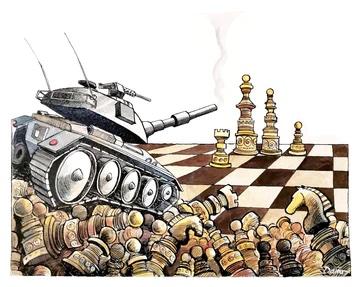
Estrategia | Darío Castillejos
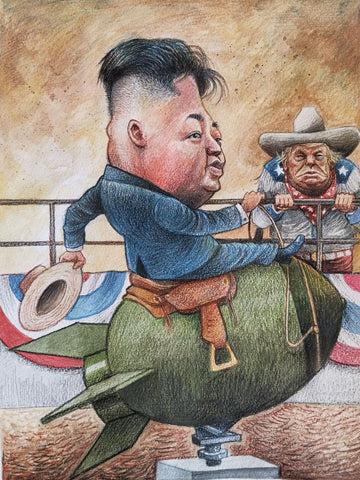
Rodeo | Darío Castillejos
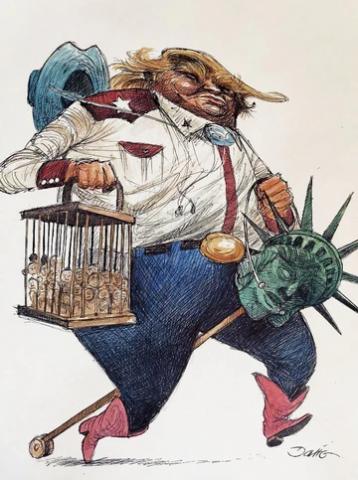
El vaquero migratorio | Darío Castillejos
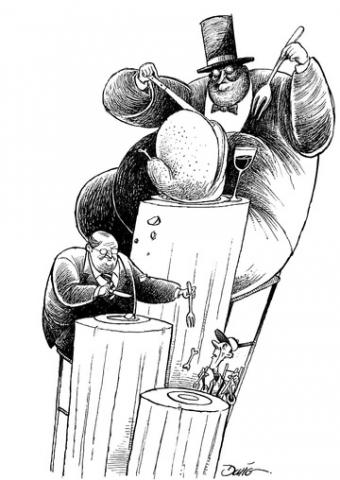
Banquete de nivel | Darío Castillejos
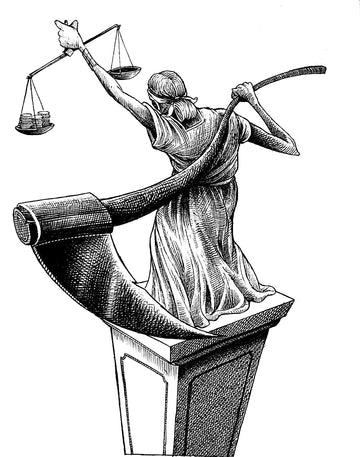
Pena de muerte 1 Darío Castillejos
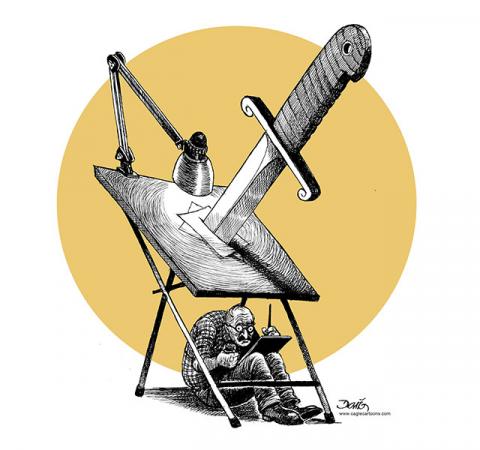
Darío Castillejos
Interview with Darío Castillejos
By Pepe Pelayo
Every day I try to be an artist who uses the tool of humor to share himself.
He is a caricaturist, illustrator, engraver and painter, born in the City of Oaxaca, Mexico in 1974. He is currently president of Cartonclub S.A. of C.V. “The Latin Caricature Club” has collaborated in the newspaper El Imparcial of Oaxaca, the magazine Foreign Affairs Latin America and the magazine El Chamuco. His work has been published in newspapers such as Le Monde, La Temps, The Nation and The New York Times, as well as in various online media agencies. He has exhibited his work in countless countries, both in individual and group exhibitions. He has published books.
And these are their awards (I don't know if all of them):
Benito Juárez García State Prize for Journalism and Information in Oaxaca in its 1997, 1999 and 2005 editions, the José Pagés Llergo National Journalism Prize in 2005. In 2012 and 2014 and 2015 he obtained the National Journalism Prize awarded by the Citizen Council in Mexico, as well as the National “Faces of Discrimination Gilberto Rincón Gallardo” award. He received the National Journalism Prize awarded by the Mexican Journalists Club in 2013. In 2011 he received the Grand Prix and First Prize in the humor category at the 38th edition of the International Humor Show in Piracicaba, Brazil, as well as First Prize in the 5th Humor Show in Patio, Brazil (ECOCARTOON) in 2012 and first place in the third International Humor Contest “Sinaloa 2014” in Mexico. He has also received Honorable Mentions in the First competition of
Greekartoon Cartoon 2006 (Hellenic Ministry of Culture, Athens, Greece), at the World Press Cartoon 2007 Sintra (Portugal) and at the 4th Patio Brasil International Exhibition. In June 2019 he received the Award of Excellence at the 19th International Editorial Cartoon Competition in Canada awarded by The Canadian Committee for World Press Freedom and in August of the same year the Award for Excellence in Journalism awarded by the Inter-American Press Society (IAPA). . In December of the current year, he received Honorable Mention in the 2018 National Journalism Award awarded by the Citizen Council of the PNP...
I got tired. It's not that I wish he would get fewer awards, it's just that if you want to know more, search for it on Google, because for a presentation I consider it excessive.
But who is this multi-award-winning man? Well, my friend Darío Castillejos.
I have the honor and enjoyment of being with him in this “dialogue.”
Although his resume is enough to interview him, I do it a lot because he was a panelist at the launch of Ángel Boligan's and my book – “Historia de bufones” – and he spoke very well, so I owe it to him. Oh, and also, I saw him receiving one of those important awards and what he said - which relates to me - I loved it.
Anyway, let's "talk" with him after such a long presentation...
PP: Dear Darío, first of all I confess that I already need to see each other “live” to talk over a coffee or a glass of wine, isn't that true? Welcome to Humor Sapiens…
DARÍO: Thank you very much dear Pepe, we really need a good talk of the kind that is seasoned with good food and of course a good wine or mezcal from Oaxaca, if you prefer.
PP: Coffee, wine, mezcal, rum or water, it doesn't matter the pretext to meet, ha, ha. Well, let's begin... How did you get into this profession?
DARÍO: I have felt the call to the profession since I was very young, perhaps and I say this without exaggeration, since before I uttered my first words. Already in preschool, it was my obsession to play with everything that could be used to make a line, from crayons to pieces of chalk or bricks that I found anywhere. In elementary school I discovered that it was the best tool to socialize and make friends; something that was not very different in the professional stage where I had the first opportunity to publish my drawings in a small magazine called "The expression of Oaxaca", owned by a lawyer friend who was also a professor at the Faculty of Law and Social Sciences, where I spent memorable days playing at studying to be a lawyer.
PP: Didn't you know that you studied to become a lawyer! Very good. But I want to take you to the characteristics of your work. For example, you obviously prefer the vignette without texts. Because?
DARÍO: I have always been passionate about painting and the plastic arts and in them the image is always the protagonist. A deeper dialogue is created with the viewer thanks to this subjective interpretation. In the cartoon, the theme is immediate and the message has to be clear and brief. My intention in working conceptually with the caricature is precisely to establish a dialogue with the viewer where not only the rictus of a smile on the surface is allowed, but the message provokes some reflection and in some way stirs critical consciousness.
PP: If I were a cartoonist I would do the same. I love the visual conceptualization in this modality, more than the use of the word. Of course there are great cartoons with text, but finding the message in a visual medium only in images fills me more. I insist, it's not that it's better or worse. It's a matter of taste, in my opinion. But anyway, you have developed a tremendous career, as can be seen in the data I sought to present to you. And as I read them again now, the question arises: which of those awards you have received have moved you the most? Which is the most significant?
DARÍO: Each award has a special story because in each one there are emotions and expectations. The National Journalism Awards in Mexico have a special meaning, since they recognize journalistic work in a country that is considered the most risky place to practice the profession. There are others that, due to their relevance in the profession, are undoubtedly important, such as the World Press Cartoon, and the Piracicaba Humor Hall, Brazil.
PP: Congratulations to all of them. They are deserved, without a doubt. My friend, also for all of the above I consider you an intense cartoonist. Your cartoons provoke emotions, impress, make you think. And they are loaded towards satire. Hence my question: do you consider yourself a political humorist?
DARÍO: That is a very interesting question because it takes me to the realms of self-criticism as an artist. I consider myself an observer of politics but a skeptic of politicians. I find in criticism the best way to express my emotions and it is, through this, that I also make known my opinion not only of political work, but of life itself. Every day I try to be an artist who uses the tool of humor to share himself.
PP: I liked that “observer of politics and skeptic of politicians.” Unfortunately, these are times when politicians leave much to be desired. I don't know if they are trained with less rigor, if they are less educated or cultured, with less ethics or are more fanatical, or all of the above, but it is evident that they give comedians many reasons for their criticism and satire in this case. Well, following that line of personalizing “criticizable” politicians, I have seen that several times you use real characters and caricature them, have you thought about dedicating more time, neurons, effort and energy to the personal caricature?
DARÍO: I like and enjoy each branch of humorous drawing, the challenge that each of them imposes excites and motivates me. Personal caricature is a branch of graphic humor that I have tackled many times, but every time I create a caricatured portrait I discover that in the end I could always have done more. I admire many colleagues who have perfected their technique in a surprising way and I try to learn from each of them on this inexhaustible path of experimentation.
PP: Even if you suffer from the creator's eternal need for perfection, after finishing the work, I assure you that you do it well. You should keep doing it for my taste. Would you like to venture, even just to experiment, into other types of content in your cartoons?
DARÍO: I really like graphic novels and I have a large number of sketches and drawings that we hope one day will come to light illustrating some personal work or that of another author.
PP: Great! I'll send you a script project that I have in the pipeline, ha ha. Well, change of “wave”… Do you censor yourself a lot? Have you ever been censored? What do you tell me about this new censorship of politically correct things that are so fashionable?
DARÍO: In a social environment like the Mexican one, the risks of exercising criticism in journalism are high; especially because power and organized crime are divided by a line that at times becomes blurred, to the point of being impossible to see where one begins and where one ends. However, the brave work of journalists who are on the front lines of the battle for freedom of expression allows information to reach the public objectively. In the case of cartoonists the task is the same, to bring the message to the readers and to do this there are countless ways that allow criticism of the different factual powers in this, skill, creativity and ingenuity play a crucial role. In my case I have not suffered open censorship of my work, although I must mention that sometimes one finds scenarios of open or veiled pressure to try to dictate editorial lines to daily work. Political correctness shows a series of complexities that sometimes border on the absurd, since they seek to redefine and put chains on a work that, as in the case of graphic humor, has been and continues to be of vital importance by promoting criticism and self-criticism in the society.
PP: I am completely right. Now, Darío, it is necessary for me to ask you this question for a book I am writing, otherwise I would not ask you because of what has been said and resaid: what are the limits of humor for you?
DARÍO: There are ethical limits in all the activities we carry out and these have to do with respect for the dignity of every living being and the constant struggle for worthy ideals such as love, freedom and justice. I believe that humor does not escape these guidelines, although it is also true that putting references and limits on these issues opens up subjective debates that seem endless. Now, it has been said that critical humor is by nature transgressive and it seems to me that for this it is necessary to understand that humor is a counterweight not only to political power but also to the excesses and absurdities inherent to individuals and societies. It is therefore important to highlight virtues such as tolerance and empathy to laugh more and learn to use the uncomfortable mirror of criticism.
PP: Unfortunately, we are far from living with that good intention of yours. I see sectors that have acquired power lately and are uncompromising in their desire to eliminate anyone who thinks differently. But I don't want to get sad now, so let's go in search of a smile: can you tell me a funny, curious or ingenious anecdote that has happened to you in your career as a cartoonist?
DARÍO: It is curious that for most of us who dedicate ourselves to graphic humor, funny anecdotes and comic absurdities are our daily bread. I have so many funny experiences that just at the moment of responding to this interview my son, the youngest, tells me that when he grows up he would like to be like his father, who does nothing and spends his time drawing and drawing. Perhaps it is that we have learned to cope with the complications of life by looking through the glasses of humor and even though reality shows us its most adverse side, we point the pencil at it and say, “Ah, but wait for me to draw you and you will see.” !”
PP: It may seem like a funny anecdote resulting from a childish prank; However, we know that adults think the same and have said it: “that person doesn't work, he spends the day at home doing nothing and only entertains himself by doodling on a piece of paper.” No idea about intellectual work, but that's life. Well, how do you see the health of graphic humor in the present and how do you see it in the future?
DARÍO: I have heard countless times that graphic humor will soon disappear and it is something that perhaps has already happened and I have not found out. I think it would be the equivalent of saying that very soon we will all stop laughing and this is better than never happening. The humor is still there, what is changing are the spaces in which it is disseminated. We have sadly seen that the media is beginning to make editorial spaces narrower, but it is also true that these, like children's drawings, always have some space to let their lines run. The Internet and other publishing platforms today have become unbeatable options for disseminating and selling works in different places. We must also mention art spaces such as engraving and painting; where I have been able to develop my passion for criticizing with humor.
PP: In other words, according to you, as long as there is life, there is humor. And we'll see where it comes from. You are optimistic, without a doubt. Many colleagues respond that there are fewer and fewer spaces and the Internet does not solve the problem of paying for copyright. But I like your optimism. Something will be invented so that graphic humor doesn't disappear, right? My friend, is there a question that I didn't ask you that you would have liked me to ask you? If so, can you answer it now?
DARÍO: I would have liked you to ask me who I consider the worst cartoonist, but in any case I wouldn't have known what to answer.
PP: Yes, I have not met a worse artist than me. For this reason, my work in graphic humor is humorous photomontage. Photoshop saved my life. So to close, can you say a few words to our Humor Sapiens followers?
DARÍO: I thank each of the readers and followers of Humor Sapiens for their attention to this interview and especially to you, dear Pepe, for all your attention, not without failing to congratulate you for the continuous effort you make in favor of humor and caricature. Receive a hug full of gratitude and affection
PP: Thank you very much, dear friend. You do what you can. Hey, I don't know if you had a good time with so many questions and maybe so "heavy." If so, excuse me. But I confess that I had a very good time. Thank you a million for accepting the interview, because I know you have a lot of work. I wish you good health and may the awards continue to fall. May your successes continue! And let's share that rum or mezcal! A hug!
DARÍO: Whenever possible it will be an honor for me to participate in these types of initiatives and once again I am grateful for this opportunity. Long live humor and may the strokes always lead us down the path of smiles!
(This text has been translated into English by Google Translate)

